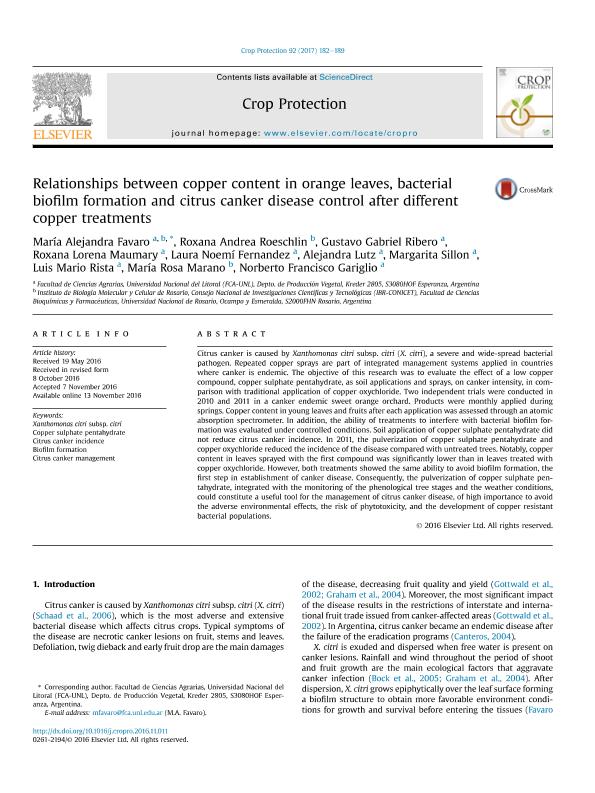Mostrar el registro sencillo del ítem
dc.contributor.author
Favaro, María Alejandra

dc.contributor.author
Roeschlin, Roxana Andrea

dc.contributor.author
Ribero, Gustavo Gabriel

dc.contributor.author
Maumary, Roxana Lorena

dc.contributor.author
Fernandez, Laura Noemí

dc.contributor.author
Lutz, Alejandra

dc.contributor.author
Sillon, Margarita
dc.contributor.author
Rista, Luis Mario

dc.contributor.author
Marano, María Rosa

dc.contributor.author
Gariglio, Norberto Francisco

dc.date.available
2022-12-02T17:14:13Z
dc.date.issued
2016-11
dc.identifier.citation
Favaro, María Alejandra; Roeschlin, Roxana Andrea; Ribero, Gustavo Gabriel; Maumary, Roxana Lorena; Fernandez, Laura Noemí; et al.; Relationships between copper content in orange leaves, bacterial biofilm formation and citrus canker disease control after different copper treatments; Elsevier; Crop Protection; 92; 11-2016; 182-189
dc.identifier.issn
0261-2194
dc.identifier.uri
http://hdl.handle.net/11336/180032
dc.description.abstract
Citrus canker is caused by Xanthomonas citri subsp. citri (X. citri), a severe and wide-spread bacterial pathogen. Repeated copper sprays are part of integrated management systems applied in countries where canker is endemic. The objective of this research was to evaluate the effect of a low copper compound, copper sulphate pentahydrate, as soil applications and sprays, on canker intensity, in comparison with traditional application of copper oxychloride. Two independent trials were conducted in 2010 and 2011 in a canker endemic sweet orange orchard. Products were monthly applied during springs. Copper content in young leaves and fruits after each application was assessed through an atomic absorption spectrometer. In addition, the ability of treatments to interfere with bacterial biofilm formation was evaluated under controlled conditions. Soil application of copper sulphate pentahydrate did not reduce citrus canker incidence. In 2011, the pulverization of copper sulphate pentahydrate and copper oxychloride reduced the incidence of the disease compared with untreated trees. Notably, copper content in leaves sprayed with the first compound was significantly lower than in leaves treated with copper oxychloride. However, both treatments showed the same ability to avoid biofilm formation, the first step in establishment of canker disease. Consequently, the pulverization of copper sulphate pentahydrate, integrated with the monitoring of the phenological tree stages and the weather conditions, could constitute a useful tool for the management of citrus canker disease, of high importance to avoid the adverse environmental effects, the risk of phytotoxicity, and the development of copper resistant bacterial populations.
dc.format
application/pdf
dc.language.iso
eng
dc.publisher
Elsevier

dc.rights
info:eu-repo/semantics/openAccess
dc.rights.uri
https://creativecommons.org/licenses/by-nc-sa/2.5/ar/
dc.subject
BIOFILM FORMATION
dc.subject
CITRUS CANKER INCIDENCE
dc.subject
CITRUS CANKER MANAGEMENT
dc.subject
COPPER SULPHATE PENTAHYDRATE
dc.subject
XANTHOMONAS CITRI SUBSP. CITRI
dc.subject.classification
Otras Ciencias Agrícolas

dc.subject.classification
Otras Ciencias Agrícolas

dc.subject.classification
CIENCIAS AGRÍCOLAS

dc.title
Relationships between copper content in orange leaves, bacterial biofilm formation and citrus canker disease control after different copper treatments
dc.type
info:eu-repo/semantics/article
dc.type
info:ar-repo/semantics/artículo
dc.type
info:eu-repo/semantics/publishedVersion
dc.date.updated
2022-12-02T14:56:14Z
dc.journal.volume
92
dc.journal.pagination
182-189
dc.journal.pais
Países Bajos

dc.journal.ciudad
Amsterdam
dc.description.fil
Fil: Favaro, María Alejandra. Consejo Nacional de Investigaciones Científicas y Técnicas. Centro Científico Tecnológico Conicet - Rosario. Instituto de Biología Molecular y Celular de Rosario. Universidad Nacional de Rosario. Facultad de Ciencias Bioquímicas y Farmacéuticas. Instituto de Biología Molecular y Celular de Rosario; Argentina. Universidad Nacional del Litoral. Facultad de Ciencias Agrarias. Departamento de Producción Vegetal; Argentina. Consejo Nacional de Investigaciones Científicas y Técnicas. Centro Científico Tecnológico Conicet - Santa Fe; Argentina
dc.description.fil
Fil: Roeschlin, Roxana Andrea. Consejo Nacional de Investigaciones Científicas y Técnicas. Centro Científico Tecnológico Conicet - Rosario. Instituto de Biología Molecular y Celular de Rosario. Universidad Nacional de Rosario. Facultad de Ciencias Bioquímicas y Farmacéuticas. Instituto de Biología Molecular y Celular de Rosario; Argentina
dc.description.fil
Fil: Ribero, Gustavo Gabriel. Universidad Nacional del Litoral. Facultad de Ciencias Agrarias. Departamento de Producción Vegetal; Argentina. Consejo Nacional de Investigaciones Científicas y Técnicas. Centro Científico Tecnológico Conicet - Santa Fe; Argentina
dc.description.fil
Fil: Maumary, Roxana Lorena. Consejo Nacional de Investigaciones Científicas y Técnicas. Centro Científico Tecnológico Conicet - Santa Fe; Argentina. Universidad Nacional del Litoral. Facultad de Ciencias Agrarias. Departamento de Producción Vegetal; Argentina
dc.description.fil
Fil: Fernandez, Laura Noemí. Universidad Nacional del Litoral. Facultad de Ciencias Agrarias. Departamento de Producción Vegetal; Argentina. Consejo Nacional de Investigaciones Científicas y Técnicas. Centro Científico Tecnológico Conicet - Santa Fe; Argentina
dc.description.fil
Fil: Lutz, Alejandra. Universidad Nacional del Litoral. Facultad de Ciencias Agrarias. Departamento de Producción Vegetal; Argentina. Consejo Nacional de Investigaciones Científicas y Técnicas. Centro Científico Tecnológico Conicet - Santa Fe; Argentina
dc.description.fil
Fil: Sillon, Margarita. Universidad Nacional del Litoral. Facultad de Ciencias Agrarias. Departamento de Producción Vegetal; Argentina
dc.description.fil
Fil: Rista, Luis Mario. Universidad Nacional del Litoral. Facultad de Ciencias Agrarias. Departamento de Producción Vegetal; Argentina
dc.description.fil
Fil: Marano, María Rosa. Consejo Nacional de Investigaciones Científicas y Técnicas. Centro Científico Tecnológico Conicet - Rosario. Instituto de Biología Molecular y Celular de Rosario. Universidad Nacional de Rosario. Facultad de Ciencias Bioquímicas y Farmacéuticas. Instituto de Biología Molecular y Celular de Rosario; Argentina
dc.description.fil
Fil: Gariglio, Norberto Francisco. Universidad Nacional del Litoral. Facultad de Ciencias Agrarias. Departamento de Producción Vegetal; Argentina
dc.journal.title
Crop Protection

dc.relation.alternativeid
info:eu-repo/semantics/altIdentifier/url/http://www.sciencedirect.com/science/article/pii/S0261219416303246
dc.relation.alternativeid
info:eu-repo/semantics/altIdentifier/doi/http://dx.doi.org/10.1016/j.cropro.2016.11.011
Archivos asociados
